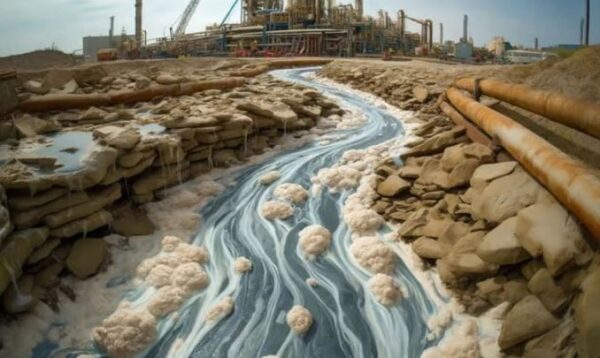A newly identified source of lithium, capable of fulfilling 40% of the US demand, has been found in wastewater resulting from hydraulic fracturing in natural gas extraction.
Wastewater from hydraulic fracturing operations. (Photo: Dall-E).
Researchers have uncovered a significant lithium deposit within the wastewater produced by a hydraulic fracturing facility in Pennsylvania. This technique, which involves injecting fluid under high pressure to fracture underground rock formations, has revealed a lithium-rich resource in the Marcellus Shale gas wells. According to a paper published in *Scientific Reports* by Justin Mackey from the National Energy Technology Laboratory and his colleagues, this wastewater contains sufficient lithium to meet 40% of the United States’ needs, as reported by *Live Science* on May 23.
Currently, Australia, Chile, and China produce 90% of the global lithium supply, valued at $8 billion. Lithium is a critical component in the manufacture of batteries for electric vehicles, smartphones, laptops, smartwatches, and e-cigarettes. The demand for lithium is surging, with prices having increased by 500% annually.
The US presently operates just one active lithium mine in Nevada, necessitating substantial imports to satisfy domestic demand. Recognizing lithium’s crucial role in the green energy transition, the US Department of Energy aims for all lithium used in the country to be sourced domestically by 2030. Several new mines are planned for states including Nevada, California, and North Carolina. However, lithium mining remains contentious due to potential environmental impacts, such as carbon dioxide emissions and soil contamination from toxic chemicals.
The discovery in Pennsylvania offers a potential alternative to traditional mining, providing a new method for lithium extraction. By analyzing the wastewater from hydraulic fracturing, researchers found it to be a rich lithium source.
Typically, the by-products of hydraulic fracturing are viewed as waste. The disposal of oil and gas wastewater poses a growing problem, with current practices involving minimal treatment and reinjection into the ground, Mackey notes. The newfound lithium in this wastewater allows for the extraction of a valuable resource, leveraging the by-products of hydraulic fracturing. Laboratory results show that up to 90% of the lithium can be efficiently extracted from the wastewater. Future research will focus on assessing the environmental impact of this extraction method and developing a pilot facility for practical application.











